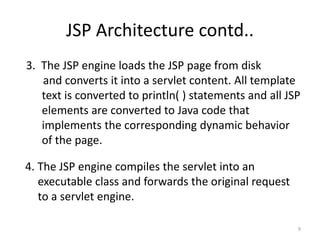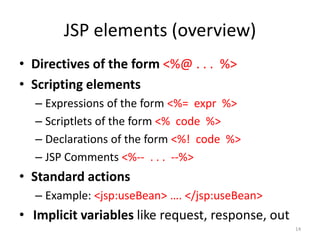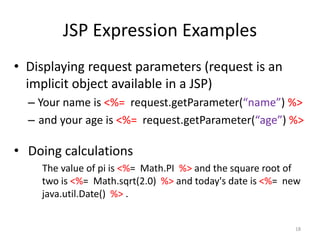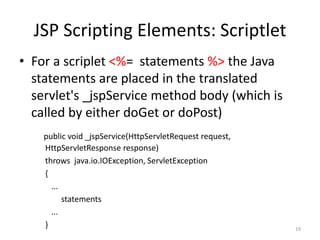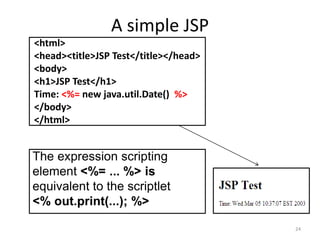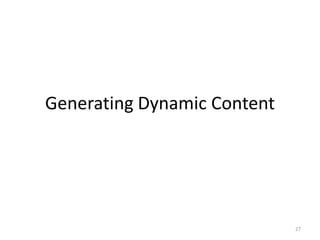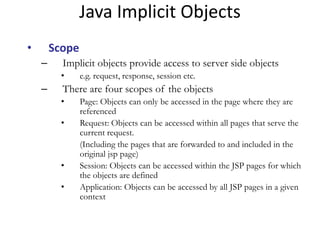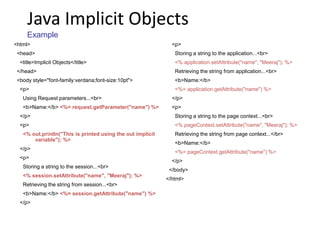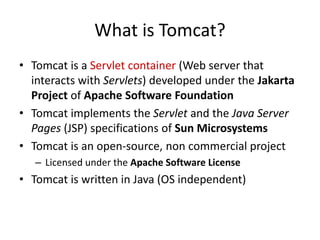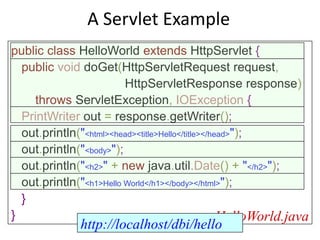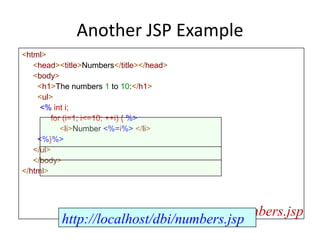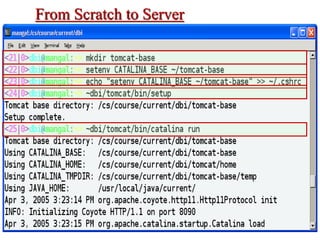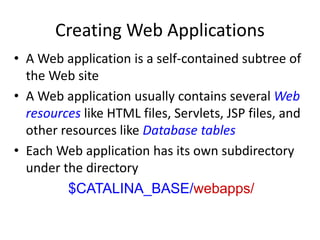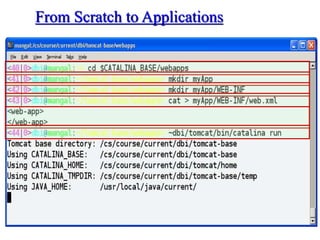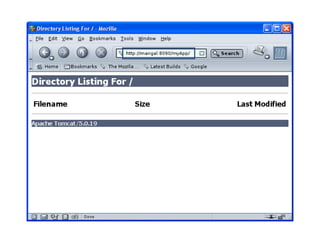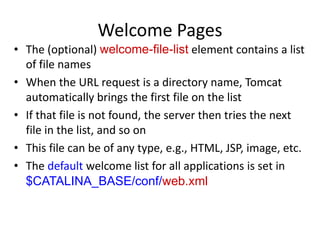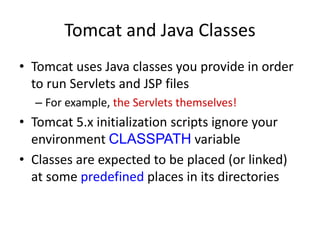JSP - Java Server Page
- 1. Java Server Pages (JSP) 1
- 2. What is JSP? • Java Server Pages (JSP) is a technology for developing web pages. • It supports dynamic content which helps developers to insert java code in HTML pages • It uses of special JSP tags, most of which start with <% and end with %>. • A Java Server Pages component is a type of Java servlet that is designed to fulfil the role of a user interface for a Java web application. 2
- 3. Why Use JSP? • JSP offer several advantages in comparison with the CGI(Common Gateway Interface). – Performance is significantly better because JSP allows embedding Dynamic Elements in HTML Pages itself instead of having a separate CGI files. – JSP are always compiled before it's processed by the server unlike CGI/Perl which requires the server to load an interpreter and the target script each time the page is requested. 3
- 4. Why Use JSP? contd.. – Java Server Pages are built on top of the Java Servlets API, so like Servlets, JSP also has access to all the powerful Enterprise Java APIs, including JDBC, JNDI, EJB, JAXP etc. – JSP pages can be used in combination with servlets that handle the business logic, the model supported by Java servlet template engines. 4
- 5. Advantages of JSP • Following is the list of other advantages of using JSP over other technologies: – vs. Active Server Pages (ASP): • dynamic part is written in Java, not Visual Basic or other MS specific language, • it is portable to other operating systems and non- Microsoft Web servers. – vs. Pure Servlets: • It is more convenient to write (and to modify) regular HTML 5
- 6. Advantages of JSP contd.. – vs. JavaScript: • JavaScript can generate HTML dynamically on the client but can hardly interact with the web server to perform complex tasks. – vs. Static HTML: • Regular HTML, of course, cannot contain dynamic information. 6
- 8. JSP Architecture contd.. 8 • JSP Processing: 1. Browser sends an HTTP request to the web server. 2. The web server recognizes that the HTTP request is for a JSP page (.jsp page) and forwards it to a JSP engine.
- 9. JSP Architecture contd.. 3. The JSP engine loads the JSP page from disk and converts it into a servlet content. All template text is converted to println( ) statements and all JSP elements are converted to Java code that implements the corresponding dynamic behavior of the page. 4. The JSP engine compiles the servlet into an executable class and forwards the original request to a servlet engine. 9
- 10. JSP Architecture contd.. 5. Servlet engine loads the Servlet class and executes it. & produces an output in HTML format, which the servlet engine passes to the web server inside an HTTP response. 6. The web server forwards the HTTP response to your browser in terms of static HTML content. 10
- 12. JSP and Servlets • Each JSP page is turned into a Java servlet, compiled and loaded. This compilation happens on the first request. After the first request, the file doesn't take long to load anymore. • Every time you change the JSP file, it will be re-compiled again. 12
- 13. Generated servlets 13 • You can examine the source code produced by the JSP translation process. • There is a directory called generated in Sun Java J2EE Application Server where we can find the source code. • Note that the _jspService method corresponds to the servlet service method. (which is called by doGet or doPost)
- 14. JSP elements (overview) 14 • Directives of the form <%@ . . . %> • Scripting elements – Expressions of the form <%= expr %> – Scriptlets of the form <% code %> – Declarations of the form <%! code %> – JSP Comments <%-- . . . --%> • Standard actions – Example: <jsp:useBean> …. </jsp:useBean> • Implicit variables like request, response, out
- 15. JSP Directives • They have the form <%@ name attribute1= “ . . .”, attribute2=“. . . ”...%> 15 page include taglib Specify page properties Include a file at translation time Specify custom tags
- 16. JSP Directive Examples • Import java packages – <%@ page import=“ java.util .*, java.sql .* ” %> • „Multiple import statements – <%@ page import=“ java.util .* ” %> – <%@ page import=“ java.sql .* ” %> • Including file at translation time – <%@ include file=“ header.html ” %> • For include the path is relative to the JSP file 16
- 17. JSP Scripting Elements: Expressions • For an expression scripting element like <%= expr %>, expr is evaluated and the result is converted to a string and placed into the JSP's servlet output stream. In a Java servlet this would be equivalent to PrintWriter out = response.getWriter(); . . . out.print(expr); 17
- 18. JSP Expression Examples • Displaying request parameters (request is an implicit object available in a JSP) – Your name is <%= request.getParameter(“name”) %> – and your age is <%= request.getParameter(“age”) %> • Doing calculations The value of pi is <%= Math.PI %> and the square root of two is <%= Math.sqrt(2.0) %> and today's date is <%= new java.util.Date() %> . 18
- 19. JSP Scripting Elements: Scriptlet • For a scriplet <%= statements %> the Java statements are placed in the translated servlet's _jspService method body (which is called by either doGet or doPost) public void _jspService(HttpServletRequest request, HttpServletResponse response) throws java.io.IOException, ServletException { ... statements ... } 19
- 20. JSP Scriplet Examples • Check a request parameter <% String name = request.getParameter("name"); if (name == null) { %> <h3>Please supply a name</h3> <% } else { %> <h3>Hello <%= name %></h3> <% } %> In this example, there are 3 scriptlets elements and one expression element 20
- 21. JSP Scripting Elements: Declaration • For a declaration <%! declarations %> the Java statements are placed in the class outside the _jspService method. • Declarations can be Java instance variable declarations or Java methods // declarations would go here public void _jspService(...) { ... } 21
- 22. JSP Declaration examples • Declaring instance variables <%! private int count = 0; %> ... The count is <%= count++ %> . • Declaring methods <%! private int toInt(String s) { return Integer.parseInt(s); } %> 22
- 23. Including Files • Including files at translation time (when JSP is translated to a servlet) <%@ include file="filename" %> • Including files at request time <jsp:include page="filename" flush = "true" /> 23
- 24. A simple JSP <html> <head><title>JSP Test</title></head> <body> <h1>JSP Test</h1> Time: <%= new java.util.Date() %> </body> </html> 24 The expression scripting element <%= ... %> is equivalent to the scriptlet <% out.print(...); %>
- 25. The Implicit out Object • In a scriptlet <% ... %> you can use the out object to write to the output stream. Example: <% out.print ("The sum is “); out.print("1 + 2 = " + (1+2)); %> 25
- 26. The Implicit request Object • In a scriptlet <% ... %> you can use the request object to access GET/POST parameters. • Example: <html> <head><title>...</title></head> <body> <h1>...</h1> <p><%= request.getParameter("greeting") %></p> </body></html> 26
- 28. Creating a JSP Page • A Sample JSP Page: easy.jsp <%@ page contentType="text/html" %> <html> <head> <title>JSP is Easy</title> </head> <body bgcolor="white"> <h1>JSP is as easy as ...</h1> <%-- Calculate the sum of 1 + 2 + 3 dynamically --%> 1 + 2 + 3 = <c:out value="${1 + 2 + 3}" /> </body> </html> 28
- 29. Installing a JSP Page • Create a Web Application directory f9406000 – easy.jsp – WEB-INF • web.xml • classes • lib – jstl.jar – libstandard.jar • war
- 30. Running a JSP Page • http://localhost:8080/f9406000/easp.jsp
- 31. Using JSP Directive Elements • page – <%@ page contentType="text/html" %> • errorPage, isErrorPage, session, pageEncoding, buffer, and autoFlush • import, language • include • taglib
- 32. JSP Comments • <%-- Calculate the sum of 1 + 2 + 3 dynamically --%>
- 33. Using Template Text <%@ page contentType="text/html" %> <%@ taglib prefix="c" uri="http://java.sun.com/jsp/jstl/core" %> <html> <head> <title>JSP is Easy</title> </head> <body bgcolor="white"> <h1>JSP is as easy as ...</h1> <%-- Calculate the sum of 1 + 2 + 3 dynamically --%> 1 + 2 + 3 = <c:out value="${1 + 2 + 3}" /> </body> </html>
- 34. Using JSP Action Elements • <prefix:action_name attr1="value1" attr2="value2"> action_body </prefix:action_name> • <prefix:action_name attr1="value1" attr2="value2" /> • <%@ taglib prefix="c" uri="http://java.sun.com/jsp/jstl/core" %> ... <c:out value="${1 + 2 + 3}" />
- 35. Standard action elements Action element Description <jsp:useBean> Makes a JavaBeans component available in a page <jsp:getProperty> Gets a property value from a JavaBeans component and adds it to the response <jsp:setProperty> Set a JavaBeans property value <jsp:include> Includes the response from a servlet or JSP page during the request processing phase <jsp:forward> Forwards the processing of a request to a servlet or JSP page <jsp:param> Adds a parameter value to a request handed off to another servlet or JSP page using <jsp:include> or <jsp:forward>
- 36. Standard action elements Action element Description <jsp:plugin> Generates HTML that contains the appropriate browser-dependent elements (OBJECT or EMBED) needed to execute an applet with the Java Plugin software <jsp:attribute> Sets the value of an action attribute based on the body of this element <jsp:body> Sets the action element body based on the body of this element. Required when the action element body contains <jsp:attribute> action elements <jsp:element> Dynamically generates an XML element, optionally with attributes and a body defined by nested <jsp:attribute> and <jsp:body> actions <jsp:text> Used to encapsulate template text that should be used verbatim; typically only needed in JSP pages written as XML documents
- 37. • Scope – Implicit objects provide access to server side objects • e.g. request, response, session etc. – There are four scopes of the objects • Page: Objects can only be accessed in the page where they are referenced • Request: Objects can be accessed within all pages that serve the current request. (Including the pages that are forwarded to and included in the original jsp page) • Session: Objects can be accessed within the JSP pages for which the objects are defined • Application: Objects can be accessed by all JSP pages in a given context Java Implicit Objects
- 38. • request: Reference to the current request • response: Response to the request • session: session associated woth current request • application: Servlet context to which a page belongs • pageContext: Object to access request, response, session and application associated with a page • config: Servlet configuration for the page • out: Object that writes to the response output stream • page: instance of the page implementation class (this) • exception: Available with JSP pages which are error pages Java Implicit Objects List
- 39. <html> <head> <title>Implicit Objects</title> </head> <body style="font-family:verdana;font-size:10pt"> <p> Using Request parameters...<br> <b>Name:</b> <%= request.getParameter("name") %> </p> <p> <% out.println("This is printed using the out implicit variable"); %> </p> <p> Storing a string to the session...<br> <% session.setAttribute("name", "Meeraj"); %> Retrieving the string from session...<br> <b>Name:</b> <%= session.getAttribute("name") %> </p> Java Implicit Objects Example <p> Storing a string to the application...<br> <% application.setAttribute("name", "Meeraj"); %> Retrieving the string from application...<br> <b>Name:</b> <%= application.getAttribute("name") %> </p> <p> Storing a string to the page context...<br> <% pageContext.setAttribute("name", "Meeraj"); %> Retrieving the string from page context...</br> <b>Name:</b> <%= pageContext.getAttribute("name") %> </p> </body> </html>
- 40. • Save file: – $TOMCAT_HOME/webapps/jsp/Implicit.jsp • Access file – http://localhost:8080/jsp/Implicit.jsp?name=Sanjay • Results of the execution Using Request parameters... Name: sanjay This is printed using the out implicit variable Storing a string to the session... Retrieving the string from session... Name: Meeraj Storing a string to the application... Retrieving the string from application... Name: Meeraj Storing a string to the page context... Retrieving the string from page context... Name: Meeraj Example Implicit Objects Deploy & Run
- 41. Apache Tomcat Representation and Management of Data on the Web
- 42. What is Tomcat? • Tomcat is a Servlet container (Web server that interacts with Servlets) developed under the Jakarta Project of Apache Software Foundation • Tomcat implements the Servlet and the Java Server Pages (JSP) specifications of Sun Microsystems • Tomcat is an open-source, non commercial project – Licensed under the Apache Software License • Tomcat is written in Java (OS independent)
- 43. A Servlet Example public class HelloWorld extends HttpServlet { public void doGet(HttpServletRequest request, HttpServletResponse response) throws ServletException, IOException { PrintWriter out = response.getWriter(); out.println("<html><head><title>Hello</title></head>"); out.println("<body>"); out.println("<h2>" + new java.util.Date() + "</h2>"); out.println("<h1>Hello World</h1></body></html>"); } } HelloWorld.java http://localhost/dbi/hello
- 44. A JSP Example <html> <head> <title>Hello World</title> </head> <body> <h2><%= new java.util.Date() %></h2> <h1>Hello World</h1> </body> </html> hello.jsp http://localhost/dbi/hello.jsp
- 45. Another JSP Example <html> <head><title>Numbers</title></head> <body> <h1>The numbers 1 to 10:</h1> <ul> <% int i; for (i=1; i<=10; ++i) { %> <li>Number <%=i%> </li> <%}%> </ul> </body> </html> numbers.jsp http://localhost/dbi/numbers.jsp
- 46. Running Tomcat
- 47. Tomcat Directory Structure Tomcat-Home bin common Tomcat-Base webapps work lib classesROOT myApp1 myApp2server.xml WEB-INF lib classesweb.xml server sharedlogsconf lib classes
- 48. Base and Home Directories • The directory TOMCAT-HOME contains executables and libraries required for the server launching, running and stopping – This directory is placed under /usr/local/… • The directory TOMCAT-BASE contains the Web-site content, Web applications and configuration data – This directory is placed under your home directory
- 49. Installing Tomcat • Create a directory for tomcat base – For example: mkdir ~/tomcat-base • Set the environment variable CATALINA_BASE to your tomcat-base directory – For example: setenv CATALINA_BASE ~/tomcat-base – Insert this line into your .cshrc file • Run ~dbi/tomcat/bin/setup • $CATALINA_BASE is now a regular Tomcat base directory, and Tomcat is ready to run
- 50. Running Tomcat • To start tomcat use ~dbi/tomcat/bin/catalina run • Or, in background, ~dbi/tomcat/bin/catalina start • To stop tomcat use ~dbi/tomcat/bin/catalina stop • To see the default page of Tomcat from your browser use the URL http://<machine-name>:<port>/ – machine-name is the name of the machine on which Tomcat runs and port is the port you chose for Tomcat • You can also use http://localhost:<port>/ if your browser runs on the same machine as Tomcat
- 51. From Scratch to Server
- 53. Choosing a port for Tomcat • In the file $CATALINA_HOME/conf/server.xml you will find the element Connector of Service “Catalina” • Choose a port (greater than 1024) and change the value of the port attribute to your chosen one: <Server> … <Service name="Catalina”> <Connector port="8090"/> … </Service> … </Server>
- 55. Creating Web Applications • A Web application is a self-contained subtree of the Web site • A Web application usually contains several Web resources like HTML files, Servlets, JSP files, and other resources like Database tables • Each Web application has its own subdirectory under the directory $CATALINA_BASE/webapps/
- 56. The Directory Structure of a Web Application • Tomcat automatically identifies a directory $CATALINA_BASE/webapps/myApp/ with the relative URL /myApp/ • For example, a file named index.html in myApp is mapped to by the following URLs: http://machine:port/myApp/index.html http://machine:port/myApp/
- 57. The Directory Structure of a Web Application • You can also use subdirectories under myApp • For example: the file myApp/myImages/im.gif is mapped to by the URL http://machine:port/myApp/myImages/im.gif • By default, Tomcat maps the root directory (http://localhost:8090/) to the directory webapps/ROOT/ – You can change this default
- 58. The Directory Structure of a Web Application • An application's directory must contain the following: –The directory WEB-INF/ –A legal web.xml file under WEB-INF/ myApp WEB-INF web.xml <web-app> </web-app>
- 59. From Scratch to Applications
- 61. Configuring a Web Application • Application-specific configuration and declarations are written in the file myApp/WEB-INF/web.xml • This file contains: – Servlet declarations, mappings and parameters – Default files for directory requests – Error pages (sent in cases of HTTP errors) – Security constraints – Session time-out specification – Context (application) parameters – And more…
- 62. Error Pages • Use the error-page element to define the page sent in case of an HTTP error that occurs within the application context • An error page element has two sub elements: –error-code - the HTTP error status code –location - the page that should be sent
- 63. Welcome Page Example <html> <head><title>Not Found</title></head> <body> <h1 style="text-align:center; color:green"> Sorry, no such file... </h1> </body> </html> my404.html <web-app> <error-page> <error-code>404</error-code> <location>/my404.html</location> </error-page> </web-app> web.xml
- 66. Welcome Pages • The (optional) welcome-file-list element contains a list of file names • When the URL request is a directory name, Tomcat automatically brings the first file on the list • If that file is not found, the server then tries the next file in the list, and so on • This file can be of any type, e.g., HTML, JSP, image, etc. • The default welcome list for all applications is set in $CATALINA_BASE/conf/web.xml
- 67. Welcome Page Example <html> <head><title>Welcome</title></head> <body> <h1 style="text-align:center; color:red"> Welcome Dear Visitor! </h1> </body> </html> welcome.html <web-app> <welcome-file-list> <welcome-file>welcome.html</welcome-file> <welcome-file>index.html</welcome-file> <welcome-file>index.jsp</welcome-file> </welcome-file-list> </web-app> web.xml
- 69. Tomcat and Java Classes • Tomcat uses Java classes you provide in order to run Servlets and JSP files – For example, the Servlets themselves! • Tomcat 5.x initialization scripts ignore your environment CLASSPATH variable • Classes are expected to be placed (or linked) at some predefined places in its directories
- 70. Java Class Locations • Tomcat expects to find Java classes in class files (in a directory named classes) and JAR files (in a directory named lib) in the following places: • TOMCAT-HOME/common/ – Basic runtime classes. No need to touch this directory • $CATALINA_BASE/shared/ – Classes that are used by all the Web applications • $CATALINA_BASE/webapps/myApp/WEB-INF/ – Application-specific classes (Servlets are typically here)
- 71. Java Class Locations Tomcat-Home bin common Tomcat-Base webapps work lib classesROOT myApp1 myApp2server.xml WEB-INF lib classesweb.xml server sharedlogsconf lib classes
- 75. Web Archives • A WAR (Web ARchive) file is a JAR file that contains a whole Web-application directory • For example, to create a WAR file of myApp do: jar cvf myApp.war webapps/myApp/* • Tomcat unpacks all WAR files found in $CATALINE_BASE/webapps/ at statup – The unpacked directory and context will be named as the WAR file name (without the .war extension) – The WAR will not be unpacked if webapps/ already contains the directory and the WAR is not newer...
- 76. Reflecting Application Changes • Changes in your Java classes may not be reflected in your application – Old versions may already have been loaded – The application needs to be reloaded • Changes in other files like HTML or JSP are always reflected • Modification of web.xml automatically causes the application to be reloaded
- 77. Tomcat Manager • Tomcat 5.0 comes with a Web application called “manager”, which supports functions for managing Web applications • You can either use the HTML interface at http://<machine>:<port>/manager/html/ or send direct HTTP requests to it • You will need to authenticate as a privileged user – Use the username “admin” with no password
- 78. Tomcat Manager • Using the manager, you can – Deploy a Web application by posting a WAR file – Undeploy a deployed Web application – Start/stop a Web application (make it available/unavailable) – Reload an existing Web application (unpack new WARs) • Warning: while “stop” makes an application unavailable, “undeploy” deletes the application directory and WAR file from webapps/








